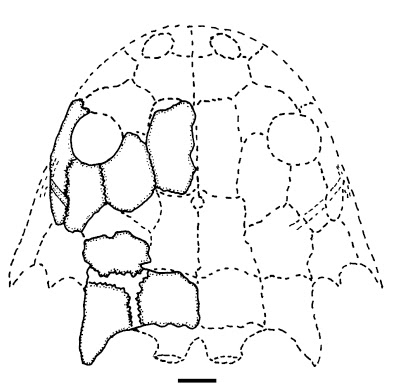The Temnospondyls were an ancient group of Amphibians, thought to have been the first group of Vertebrates fully adapted to life on land. They flourished in the Carboniferous, Permian and Triassic, with a small number surviving as late as the Cretaceous. They were much larger than modern Amphibians, and were quite different in appearance, with boney armoured plates, scales and well developed claws. Nevertheless some experts have suggested that the Lisamphibians (modern Amphibians) are descended from the Temnospondyls.
In a paper published in the January 2012 edition of the journal Palaeontology, Sérgio Dias-da-Silva of the Laboratório de Paleobiologia at Campus de São Gabriel at the Universidade Federal do Pampa, Dhurjati Sengupta of the Geological Studies Unit at the Physics and Earth Science Division at the Indian Statistical Institute, and Sérgio Cabreira and Lúcio da Silva of the Laboratório de Paleontologia at the Universidade Luterana do Brasil, describe an immature Temnospondyl Amphibian from the upper levels of the Santa Maria Formation in the Municipality of São João do Polêsine in the State of Rio Grande do Sul, Brazil.
The new specimen closely resembles Compsocerops cosgriffi, a Late Triassic Temnospondyl from India, and assigned to the genus Compsocerops, though due to the fragmentary nature of the specimen, and the fact that it appears to be a juvenile, it is not given a specific name. The specimen comprises a partial skull, part of a jawbone, a fragment of the clavicle (collarbone), and part os a humerus (upper arm bone). The specimen is considered to be a juvenile because the bones appear thin with widely separated sutures, and the simple ornamentation of the bones; the ornamentation of a mature Temnospondyl being rather more elaborate.
Compsocerops sp., cranial fragment; (A) photograph in dorsal view, (B) photograph in lateral view, (C) interpretive drawing of (A), (D) interpretive drawing of (B). Abbreviations: aj, alar process of the jugal; f, frontal; is, infraorbital sulcus; j, jugal; po, postorbital; pof, postfrontal. Scale bars represent 10 mm. Dias-da-Silva et al. (2012).
Compsocerops sp., second cranial fragment; (A) photograph in dorsal view, (B) photograph in lateral view, (C) interpretive drawing of (A), (D) interpretive drawing of (B). Abbreviations: pp,
postparietal; ppp, postparietal process; ptf, posttemporal fenestra; st, supratemporal; t, tabular. Scale bars represent 10 mm. Dias-da-Silva et al. (2012).
Compsocerops sp., reconstruction of the skull, based on available material. Scale bar represents 10 mm. Dias-da-Silva et al. (2012).
Compsocerops sp.: (Top) part of the mandible in (A) dorsal view, (B) labial view, and (C) lingual view. (Bottom) partial clavicle in (D)ventral view and (E) dorsal view. (F) Partial humerus in ventral view. Abbreviation: dg, deep groove. Scale bars represent 10 mm. Dias-da-Silva et al. (2012).
See also Two new species of Moss from the Permian of Brazil, Three new species of Frog from the Peruvian Andes, New species of Robber Frog from Panama, A cryptic species of Ground Frog from southern Chile and A Salamander from the Late Jurassic of China.
Follow Sciency Thoughts on Facebook.




